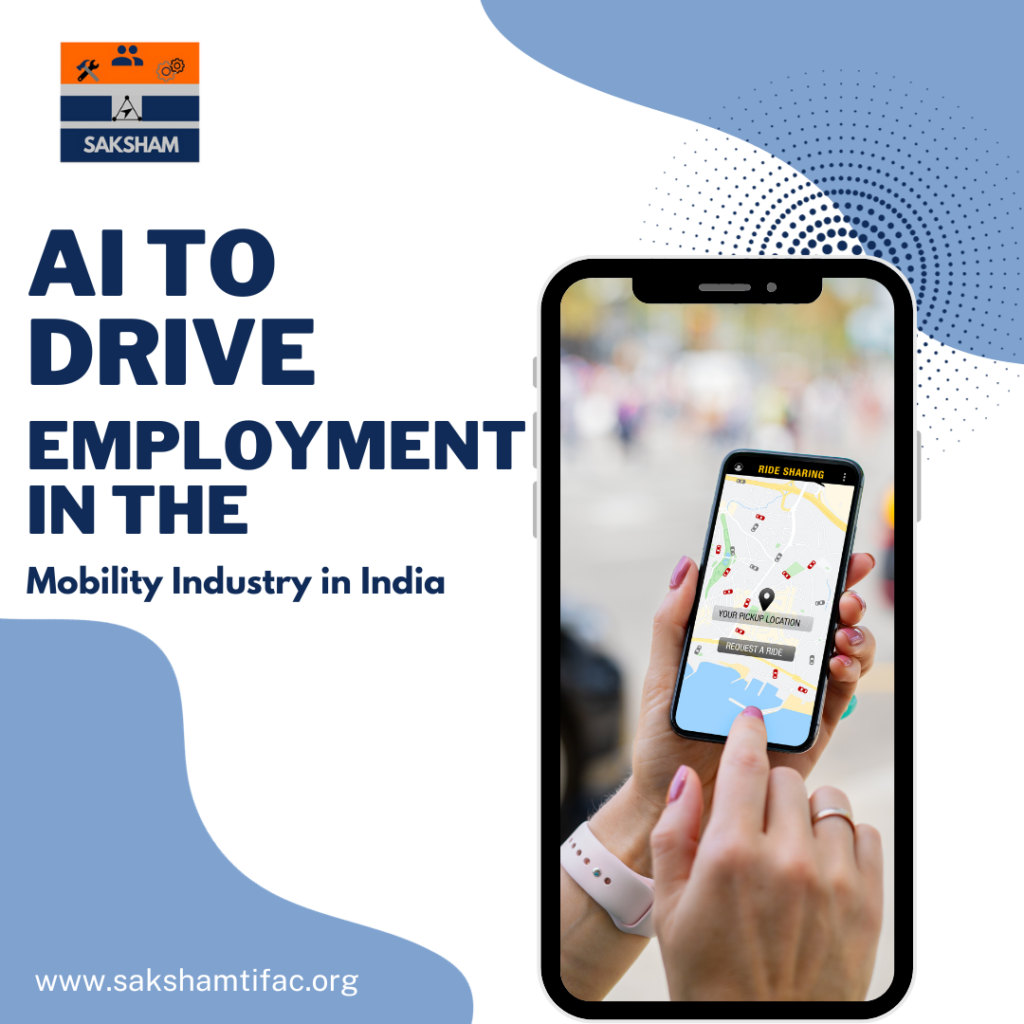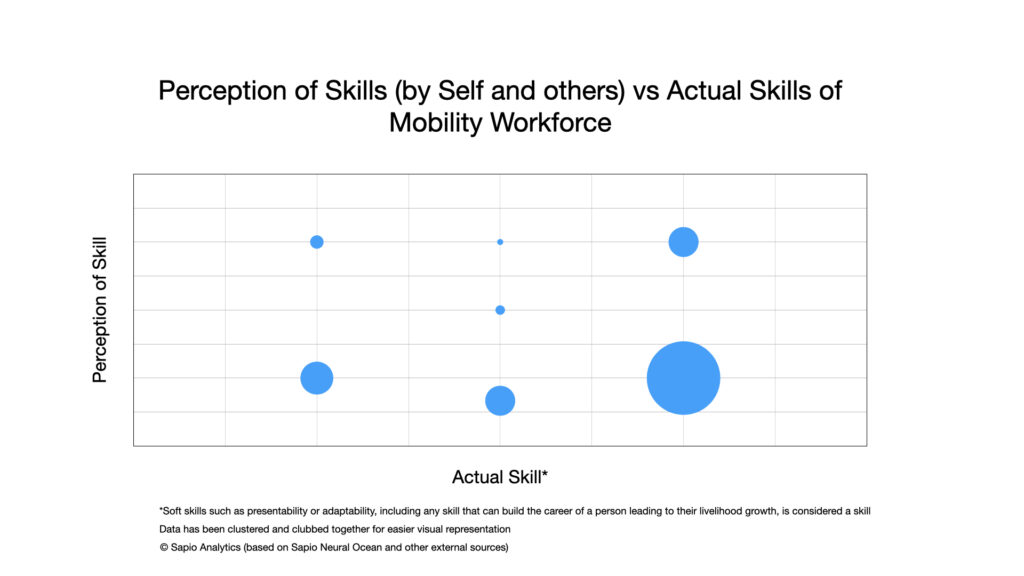The mobility Sector is expected to become the fastest growing sector employing the youth of India and play a critical role in the Government of India’s mission to end unemployment, thanks to AI.

The number of people being employed or self-employed as drivers (in ride hailing companies such as Uber, Ola, BluSmart, Indrive, and others), or as delivery agents (in fast commerce and quick delivery companies such as Swiggy, Zomato, Blinkit, Zepto, Bigbasket, and others), or as goods vehicles drivers (in transportation companies such as Agarwal Packers and Movers, Delivery, and others), is on a constant rise.
While the employment is increasing in this sector at a fast pace, an increase in dissatisfaction amongst all stakeholders, particularly the workforce, as well as attrition in the workforce is also on an all-time high. Growth in the sector is needed, but along with the empowerment of this segment. Without an integrated empowerment, the companies in this sector will find their growth unsustainable and many of them are expected to lose their unicorn status.
Can growth in business and empowerment of drivers/delivery agents go hand in hand?
Not only do they go hand in hand, the sustainable growth of any business is largely dependent on empowerment of their low income workforce, whether contractual or employed.
Based on experiments done by our partners in cities across India, we have identified direct correlations between satisfaction levels of the workforce and their performance leading to higher business for the companies they are contracted or employed with. It was seen that drivers/riders who were able to contribute better unit economics to the company, were the ones who were making more money and were more satisfied and stable with their jobs. Positively engaged workforce showed more than 50% higher business impact (measured in terms of unit economics of revenue minus direct expenses) than the neutral workforce, in various cases.
The only challenge these companies may face is in their ability to ensure such satisfaction and stability without compromising on their unit economics. Ideally, if they can appoint one people manager, with excellent domain expertise and the knowledge of behavioural science, for one member of this workforce, they will achieve such high standards of satisfaction and excellence. But it is practically impossible to do so.
Hence, the government recommends the use of artificial intelligence. If these companies can use artificial intelligence driven management, replicating the impact of an individual manager for every single workforce, the business grows with limited financial investments.
Data shows empathetic understanding of family conditions and socio-economic background is key towards retention and performance.
A fleet manager or a driver manager may not have the emotional intelligence to understand family conditions and socio-economic background of the workforce that they are managing. Hence, they may fail to focus on what is considered to be the most significant parameter in ensuring higher retention and performance of this workforce.
Here are some important attributes of this workforce that needs to be understood (the points mentioned here are only surficial in nature, and provided courtesy in-depth analytics by Sapio Analytics, and data from Sapio Neural Ocean; deeper analytics can be provided by Sapio Analytics):
- The biggest worry of the best performers in the mobility industry is how their family perceives their work and how they are treated by their family members.
- The biggest worry of the non-performers from this industry is a combination of external factors that may impact their numbers. This reflects that their behaviour lacks the desire or capability of introspection, with the presence of a high degree of deflection.
- The retention of the workforce is directly proportional to their performance, if the performance metrics are also directly connected to their earnings. If the performance metrics are not connected to their earning, their retention is directly proportional to their sense of achievement.
- Hence, for a driver in the ride hailing industry, the ones who are earning more may consider number of hours being online (or number of hours spent on work) as a prime factor of their performance, while those earning less may look at earning per hour as a prime factor of their performance. This is true for truck drivers and delivery riders as well. If they perceive they are performing better, their chances of retention increases.
- Engagement of the workforce is critical for their retention and performance, and engagement becomes better when done in their local language. Local language with local tones is what makes a conversation more powerful. Companies should not kill the “power of local” in an attempt to be central. More importantly, local does not just mean work location but also the home location.
- Sense of community and a sense of purpose is missing in most of the current mobility workforce. People are willing to earn slightly less for a significantly more sense of community powered by respect.
- Tough environmental conditions make them eager to earn more, posing possibilities of greater business. They should be rightly incentivised in such cases. Monsoons, bad roads, tough routes, do not discourage the majority of this workforce, the lack of incentivization in such cases does.
- Moods change, but when they are happy, the general mobility workforce wishes to do work more and avoid idle hours.
- When they are missing their loved ones, because of long work hours, they may not be inclined to reduce work hours but rather be inclined to compensate for their desires by exploring other available options. This trait can be geared in the right direction.
- The workforce has the potential to grow and build a career based on the learning they receive as a delivery agent or as a driver, but are not aware of the same.
One of the major outputs that we have seen through a deep dive into the behaviour of this workforce is the fact that they may possess good skills to help them build a growing career, but lack in belief of the presence of such skills. This lack of belief percolates to their managers and leaders too.

Research Courtesy and Copyright: The research belongs to Sapio Analytics, an organisation focused on using data and AI to transform livelihoods of low income workforce. Disclaimer: These points are only superficial glimpses into this workforce. The Neural Ocean by Sapio Analytics, nodal agency of Saksham, deep dives into this specific workforce and provides insights that can transform the sector, using Artificial Intelligence.
How can businesses in this sector empower their workforce while enhancing their profits?
There is a tendency in most businesses of the modern world to treat their contractual mobility workforce as a short term resource. There is a growing belief that there will be a high attrition, and hence they need not care a lot about this workforce thinking about a long term engagement, thus converting this into a self-fulfilling prophecy.
There are a number of activities these companies can do, and here are a few recommendations (these recommendations are surficial in nature and a deep dive analytics can be provided as required):
- For the workforce of this sector, time to do other things is very less as their job is time intensive running into more than 12 hours a days; but their ambition is high (generalised). Always give them the belief that there is a guide for them working on their career growth. As long as they are aware that their livelihood is being cared for, they will keep on contributing positively.
- Skills like patience and adaptability need to be taught. The feeling that they are unskilled has to be removed.
- This work is making them learn certain skills, that will enhance the potential of their future earning. For example, doing good work at driving makes them appreciate their family more and increases their adaptability in different situations. Make them aware of the same.
- Going home, taking breaks, is fine, and much more common in this segment than other industries. There should be a well designed strategy to compensate for the losses during the same. Remain in touch with them even if they have temporarily taken a sabbatical.
- The environmental conditions that they operate in play a very important role in their mindset, and in the degree to which they can be nurtured. Hence, a driver driving in monsoons is different from the same driver driving during summers. Understand the difference, appreciate the difference, and create new strategies based on the difference.
- Entrepreneurial thinking in some helps create a better tip culture, adding more to their livelihood. This should be promoted and the right ones should be trained to earn more through tips. Bring in tips and make it part of your existence.
- Don’t just keep on pushing for more, look at the long term play. If they are already performing a lot, they should be appreciated and not pushed for more.
- Show them the impact that they are creating, and how they are doing an important job by helping people and the economy.
- When they are missing their loved ones, because of long work hours, they may not be inclined to reduce work hours but rather be inclined to compensate for their desires by exploring other available options. This trait can be geared in the right direction.
The above actions may seem tough to implement, but the Government of India is here to serve the businesses of India, work with them, and create an ecosystem where every workforce of the mobility industry feels empowered and supported by a lifetime guide, helping them grow in their career. Government provides a guide to all (through use of Artificial Intelligence driven tools provided by Sapio Neural Ocean, an intelligent data lake of the nodal agency of Saksham), connect with us to know how to implement it for your organisation, and become part of this transformation, leading to a strong economy of India.
Manipulate vs Empower: The core differences
The use of psychological hacks to influence the behaviour of the workforce has been a common strategy by various data driven companies in the sector. In many cases, such hacks have been proven to be manipulative rather than empowering. It was so, because a genuine effort to positively empower the workforce by providing them a guide that thinks of the workforce before thinking of the business, has been missing.
This is despite the fact that once this workforce is empowered without just thinking of the central interest of the company, the overall central interest of the company will definitely be enhanced and positively impacted!
Some of the leading ride hailing companies of the world are known to have used communication techniques that were meant to make their drivers drive more, including the use of often-abused “Fear of Missing Out strategy”.
Empowerment is not about creating fear but about showing opportunities.
A simple example is:
If a driver is not driving in an area where they can earn high, they should not be pushed through fear that they are missing out on earning. Rather, they should be empowered with knowledge that they can earn more if they drive in specific areas, and why they should choose to drive in these areas.
If the above is done, not only will the drivers go to these areas, but they will know that they are controlling their narrative, and hence will perform more in these areas.
Another example is:
Many organisations think that by not giving their workforce time to think (for example, by doing a blanket push of new rides even before the current ride is ended), they may extract more performance from them. This is a false assumption, if numbers are seen in the long run, and if factors like cancellation rates and their correlation with attrition are taken into account. Just like every other workforce, some time to make them realise that they are in control of their finances, by showing them empathy of a personalised understanding of their expectations, capabilities and desires, can change things significantly for these businesses.
The examples can go on.
Engage more. Those who engage and those who feel connected, especially those who give time to do this engagement, always perform better. They are the ones who do not leave. They are the ones who grow the company.
Where does the Government of India stand?
The government believes in the use of new age technologies in helping empower the mobility workforce of India, and requests companies to start adopting these technologies. The government believes in providing direct support to companies, through its own systems, under its mission Saksham, aimed at ending unemployment in India.
Once companies start adopting these, they are expected to empower their workforce, retain them, reform them by enhancing their performance, and increase the companies’ revenues or profits in the process.
Companies may choose any systems available in India or outside to achieve the same.
Interested companies may apply to work closely with various missions of the Government, and pledge their support to the cause.



